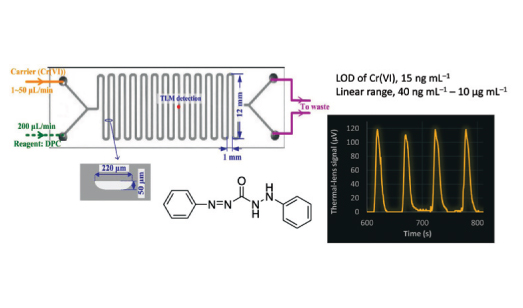Determination of Trace Cr(VI) with Diphenylcarbazide by μFIA–Thermal Lens Microscopy
DOI:
https://doi.org/10.17344/acsi.2016.2549Keywords:
photothermal lensing, thermal-lens microscopic detection, microfluidic applications, μFIA, hexavalent chromium, diphenylcarbazideAbstract
The optimum reaction parameters for the interaction of hexavalent chromium [Cr(VI)] with diphenylcarbazide in microfluidic chips (μFIA) with thermal-lens microscopic detection were selected. The characteristic feature of the applied flow scheme is the injection of the reagent into the stream containing the test metal, which enables in-field and real-time monitoring of Cr(VI) simply by flowing the sample continuously through the microchip. The limit of detection of Cr(VI) under the selected conditions (signal generating wavelength, 514.5 nm; excitation power, 100 mW; detection position, 10 cm downstream from the mixing zone of the microchip; flow rate 10 μL min–1; injection volume, 1.4 μL) is 15 ng mL–1 (2.9×10–7 mol L–1). The linear range is 40 ng mL–1 – 10 μg mL–1 with a relative standard deviation no higher than 10% in the concentration range 0.1–1 μg mL–1. The online monitoring by this scheme provides the possibility of up to 360 analyses per hour.

Downloads
Additional Files
Published
Issue
Section
License
Except where otherwise noted, articles in this journal are published under the Creative Commons Attribution 4.0 International License
